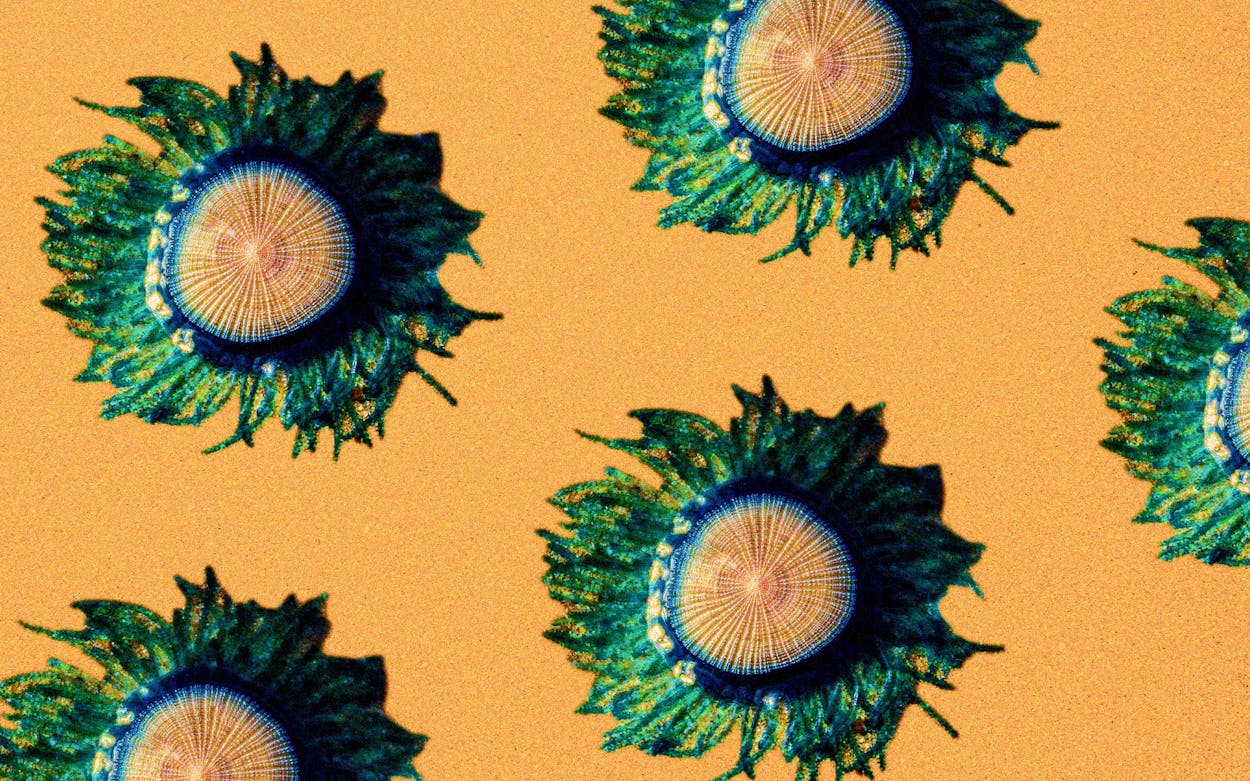Maureen Nolan-Wilde was walking alongside the beach near her home in Galveston last week when she noticed several small blue-green objects. “They were everywhere,” she says, “just all over the beach.” She recognized the eye-catching blobs as blue button jellyfish: tiny sea creatures that look like a stained-glass sand dollar, with cerulean tentacles attached to a glittering disc. Nolan-Wilde (a member of the Galveston Bay Area Chapter of the Texas Master Naturalist program) is not the only beachgoer to notice these blue gems washed ashore. Lots of Texans have spotted them on Gulf Coast beaches recently, and the animals are starting to find viral fame online.
Similar to their closest relatives, sea sails (also called by-the-wind sailors) and their more distant cousins, the infamous Portuguese man-of-war, blue button jellies are “passive drifters” that rely on ocean currents to move around. Out in the open seas, these blue dudes and their ilk can propagate in the hundreds. Spending most of their lives on the ocean’s surface, they munch on “small plankton and larval crustaceans, and act as a food source for the blue sea dragon,” says Jace Tunnell, a research scientist at the University of Texas Marine Science Institute in Port Aransas. As the summer sun warms the Gulf of Mexico, plankton bloom and saturate our shallow coastal waters. The blue jellies follow their food, and eddies and currents wash them ashore. There, they eventually dry up in the sun—only after becoming internet celebrities, of course. But as cute as they are, these No Name look-alikes are not what you might think.
Porpita porpita, as it’s otherwise known, is in fact not a jellyfish at all, but a cluster of even smaller creatures huddled together. Originally discovered and classified by Carl Linnaeus (the father of modern taxonomy) way back in 1758, these tiny Texans belong to a class of cnidarians (the family of animals that includes jellyfish) called the hydrozoans. Unlike a jellyfish, whose tentacles and head are part of a single specimen, the blue button is a hydropolyp colony, meaning each of its distinct blue-green tentacles is a single creature. These polyps are divided into three groups: some focus on reproduction, some on feeding, and some on defense. They are attached to their crown, at the center of which are the mouth and butt (yup, it eats and excretes from the same place). As for the blue-green and sometimes cerulean tone, Tunnell ascribes it to a simple evolutionary trait: “Blending in to the environment is their best chance of catching prey when they are dependent on the ocean current to move.”
Though the blue button isn’t really a threat to humans, jelly prospectors be warned: these little guys can pack quite a sting to those with more sensitive skin. They are also known to sicken pets (mainly dogs) that dare to eat them. Both Tunnell and Nolan-Wilde suggest observing from a distance to best admire the blue button’s beauty. Who knows what other curiosities you might spot while you’re looking down at the sand? “I always like to say, some people just get out of their car and get into the water,” says Nolan-Wilde. “And there’s a heck of a lot of stuff between them and the water.” So, spare some time on your next beach day and look a little longer at the wrack lines that mark the coast, and maybe you’ll catch a glimpse of a blue button.






